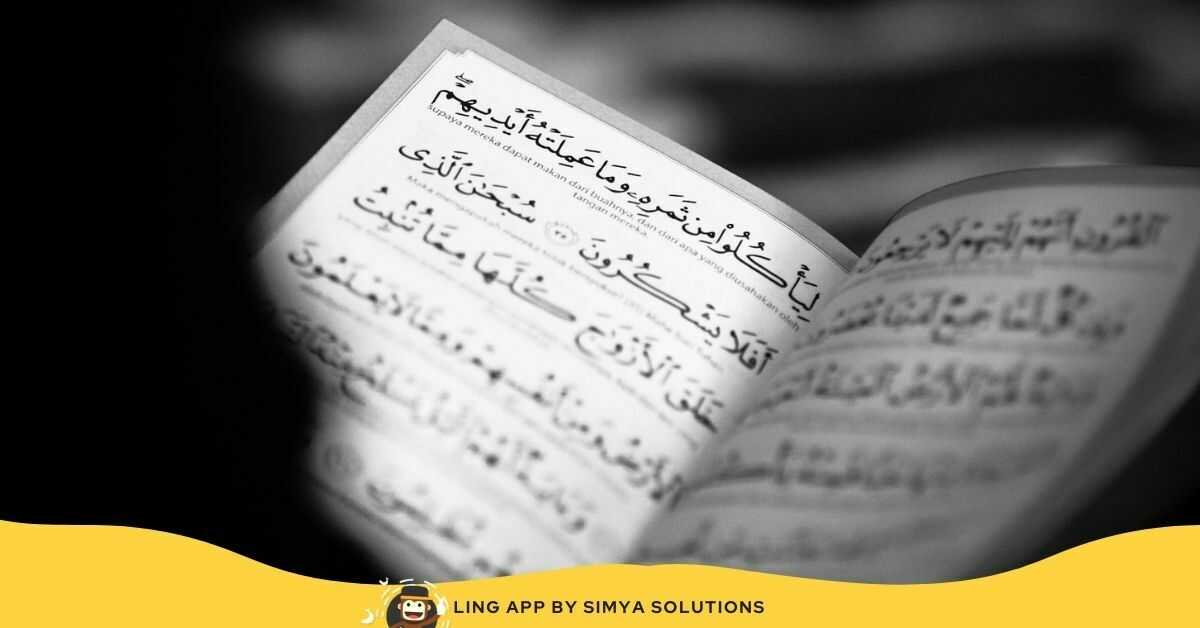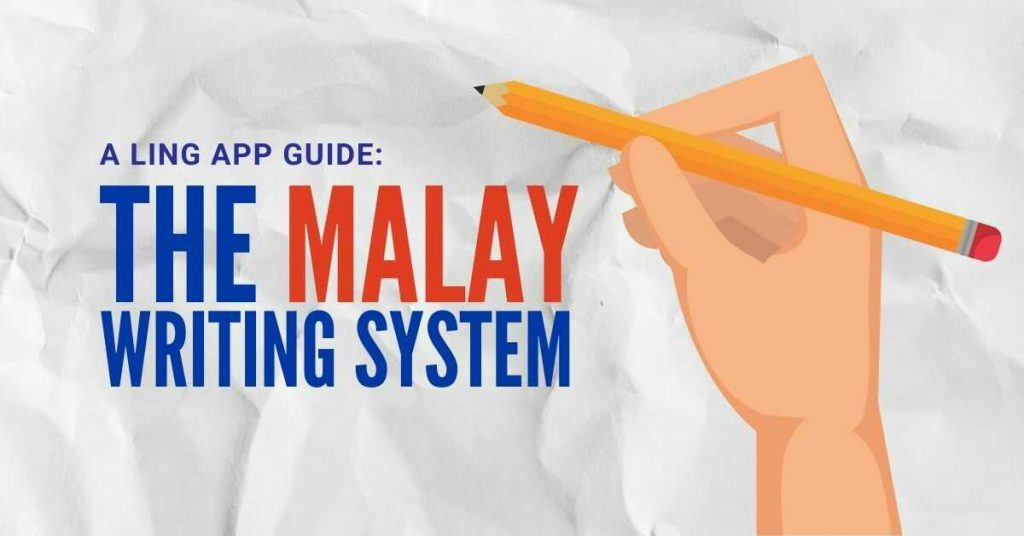If you go to the supermarket in Malaysia and pick up any product, you will most probably see some small Arabic scripts on the product along with Malay writing. Since Arabic is not an official language of Malaysia, have you ever wondered why many are still adding these translations?
Just to jog your memory a bit, Malay is the National Language of Malaysia and is spoken by millions of people in Malaysia, Singapore, Brunei, and also Indonesia (Indosenians call it the Indonesian language or Bahasa Indonesia instead). About 18 million people speak Standard Malay and about 170 million native speakers of Indonesian. Malay language and Indonesian language actually share the same history and some argue that they are the same language but with different dialects- an endless debate.
In this post, I would like you to familiarize yourself more with the writing system and alphabets used in the Malay language- both Rumi and Jawi and the history.
Malay Writing System
The Malay official scripts that are still in use today are as below:
- The Latin Script, or as the Malays call it, Rumi.
- The Arabic Script, also known as Jawi, by Malay speakers.
In modern times, every single Malaysian will learn and use the Latin Script – EVERYWHERE. It is compulsory for every Malaysian, including the non-Malays (like the Malaysian Chinese or Indian) to learn Modern Malay and to use Rumi as writing script.
However, the Malays, or to be specific, the Muslims in Malaysia are expected to learn the Jawi script as part of their syllabus for their first language. Parents usually teach Arabic letters to kids as early as they can, which is completely normal since Muslims are required to master how to read Arabic to be able to read or recite the Quran.
Since there are some letters in Malay that are not found in the Arabic writing system, there are some additional letters used in the Arabic script for Malay. For example, in Arabic, there are no/p/ or /g/ or /ch/sounds – which are common sounds in Malay, hence, the Malays made their own addition to the Arabic writing system.
History Of The Malay Writing System
Malay writing went through a few changes throughout history, mainly due to religion and the British occupation. Here is a summary of the history:
The ancient Malay people or the ‘Proto-Malay’ moved to the land of the Malay archipelago around 2500 to 1500 BC. The language used by these ancestors of Malays is classified as Old Malay. Old Malay was influenced by the Hindu religion as well as the Sanskrit language and it was widely spoken by the traders in the era of Malacca Sultanate- to the point that it was labeled as the lingua franca. Additionally, the Old Malay writing used the Pallava and Kawi script as their writing script -an Indian script and a Javanese script respectively.
Later, Islam arrived in the Malay peninsula, and many convert to the religion of Islam. Due to Arabic terms that cannot be supported by the Pallava and Kawi script, they adopted the Arabic script and made a few additions which results in the Jawi script. Jawi gradually replaced the Pallava and Kawi script and thus this era of Malay was classified as Classical Malay.
Moving on, after the occupation of Portuguese, Dutch, and British influence, the Latin script was forced upon the Malay people and thus is being used now for most of the official and informal purposes.
All these lead to the Modern-Day Malay era. You can discover how many lexicons in Malay are actually Arabic loanwords or English borrowed words. Some use the same word as used in the English word. To learn more about the history of the Malay language, you can click here.
However, to preserve the unique culture of the Malays, authorities decided to preserve Jawi and continue the legacy of the Jawi script by making it compulsory in schools for Muslims. In the Malay language examinations in Malaysia, students can choose to answer the questions in Jawi instead of Rumi; in Islamic studies for certain grades, there are parts of the exam that are compulsory to answer in Jawi.
Latin Alphabet In Bahasa Melayu (Rumi)

The Latin alphabet used as the Malay writing script is very simple, there are no additional letters or symbols in the list of alphabets. The best thing about learning Malay is that the sound of the letters seldom changes according to the word like what we have in English. For example, in English, the letter ‘T’ can be used as ‘take’ or ‘mature’, both sound completely different.
The Malay language has 6 vowel phonemes. The list of vowels are as below:
| Alphabet | Rhyming Vowel |
|---|---|
| a | father |
| e | elephant |
| e | the |
| i | in |
| o | orbit |
| u | book |
Meanwhile, the consonants are not much different than English, except it is much straightforward.
| Alphabet | Consonant Example |
|---|---|
| B | boy |
| C | Chanel |
| D | door |
| F | fun |
| G | girl |
| H | hate |
| J | jam |
| K | kite |
| L | like |
| M | man |
| N | nose |
| P | pear |
| Q | quail |
| R | run |
| S | sun |
| T | tea |
| V | vase |
| W | wine |
| X | xylophone |
| Y | yam |
| Z | zip |
| NG | sing |
| GH | Ghana |
| NY | “nyaa” |
| SY | shine |
| KH | cloud |
A little side note: the letters ‘v’ and ‘x’ are only used in loanwords, while the letter ‘q’ is used in Arabic loanwords.
Arabic Script In Bahasa Melayu (Jawi)

As I have mentioned above, the Jawi alphabet is basically the same as the Arabic alphabet, except some letters were added in the collection to adapt Malay vocabulary to it.
Here is the list of the classic Arabic alphabet:
| ﺍ | ط |
| ب | ظ |
| ت | ع |
| ث | غ |
| ج | ف |
| ح | ق |
| خ | ك |
| د | ل |
| ذ | م |
| ر | ن |
| ز | ه |
| س | و |
| ش | ي |
| ص | ء |
| ض |
In Jawi, all of the above alphabets are used, including these six additional letters not found in Classical Arabic language to fit the phonemes native the Malay pronunciation.
Additional Jawi alphabet:
- چ /t͡ʃ/
- ڠ /ŋ/
- ڤ /p/
- ݢ /g/
- ۏ /v
- ڽ /ɲ/
How To Learn Bahasa Malaysia In 3 Easy Ways

If you want to learn Malay, the first step is to master the alphabet first. Which you do not need to worry about since you do not need to learn some new writing scripts. The second step is to get yourself a dictionary because you would need to increase your vocab count to be able to make simple sentences. You don’t need to get multiple Malay dictionaries, maybe a simple one with illustrations would suffice.
The third step is to get to know Malay grammar. The easiest way to solve this is by downloading and use the Ling app. If you use the Ling App religiously, you can skip step two, to be honest. Why carry around a dictionary when Ling App can help you with grammar, vocab, simple sentences, common phrases, pronunciation, and many more aspects of languages that can help you through your journey?
So, what are you waiting for? Try Ling App today and discover a better way to learn languages.















